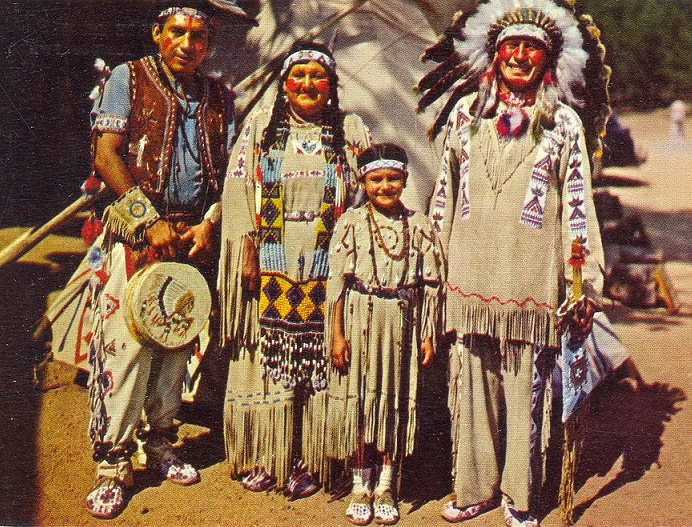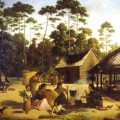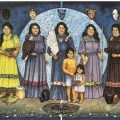
When the Europeans began their invasion of the Americas, the Cherokees were an agricultural people whose villages could be found throughout the American Southeast. Cherokee families were based on matrilineal clans. Matrilineal clans are extended family groups with names, tradition, and oral history. Membership in each clan is through the mother: you belong to your mother’s clan. To be without a clan was to be without human identity. The clan is also exogamous, which means people cannot marry a person from their own clan.
With regard to the Cherokee family, historian John Finger, in his book The Eastern Band of Cherokees 1819-1900, says:
“Most incomprehensible of all to non-Indians was the Cherokee family system.”
With regard to inheritance, the matrilineal system meant that children did not inherit from their fathers. Instead, men had a special relationship with their nephews – their sisters’ children – as these were members of their clan.
Folklorist George Lankford, in his book Native American Legends: Southeastern Legends: Tales from the Natchez, Caddo, Biloxi, Chickasaw, and Other Nations, writes:
“Another consequence of matrilineality, which both outraged and delighted Europeans, was that unmarried women were free to seek pleasure or children from anyone they chose.”
The Clans
The Cherokee had seven clans:
- Blue: (A ni sa ho ni) Also known as the Panther or Wild Cat clan
- Long Hair: (A ni gi lo hi) The Peace Chief was usually from this clan
- Bird: (A ni tsi s kwa)
- Paint: (A ni wo di) Many of the medicine people were from this clan
- Deer: (A ni ka wi)
- Wild Potato: (A ni ga to ge wi) Also known as the Bear, Racoon, or Blind Savannah clan
- Wolf: (A ni wa yah) Many war chiefs came from this clan
Looking at the Cherokee clans from a legal perspective, law professor John Reid, in his book A Law of Blood: The Primitive Law of the Cherokee Nation, reports:
“Clanship was the most fundamental of all Cherokee legal rights. Membership was too exact to be legally challenged.”
Fathers had no official relationship to their children because their children belonged to a different clan. Fathers might love their children and provide them with some care, but still the children belonged to the mother’s clan. A father did not have the right to punish his children. In fact, if a father were to harm his children, the children’s clan (that is, the clan of their mother) could hold him responsible.
The traditional roles of uncles—more specifically, the mother’s brothers—was very important in Cherokee culture. Law professor John Reid writes:
“Avuncular responsibility was the keystone of Cherokee education. So too was avuncular authority.”
For a young boy, this meant that the most important men in his childhood were his uncles, not his father. In her book Seven Clans of the Cherokee Society, Marcelina Reed writes:
“The primary responsibility for discipline and instruction in hunting and warfare rested not with the child’s father but with his maternal uncle.”
Law professor John Reid puts it this way:
“The uterine uncle was, by necessity of law as well as social custom, the disciplinary and tutorial authority in the family.”
If there was no blood uncle, then another male from the mother’s clan would assume these duties (known as a classificatory uncle).
Marriage
Among the Cherokee, individuals were not allowed to marry members of their own clan or members of their father’s clan. They were, however, encouraged to marry members of their maternal grandfather’s clan or their paternal grandfather’s clan. In general, marriage was regulated by the women of the village.
Marriage was not seen as a binding contract and divorce was common. In his book The Qualla Cherokee: Surviving in Two Worlds, sociologist Laurence French writes:
“Monogamous marriages were of short duration among the early Cherokee with some sources suggesting that it was not unusual for individuals to change spouses as frequently as three or four times a year.”
In their book The Columbia Guide to American Indians of the Southeast, Theda Perdue and Michael Green report:
“When marriages dissolved, husbands simply left their wives and children, who were not blood relatives, and returned to the houses of their mothers and sisters.”
In examining the non-Indian notion that Cherokee girls could be required to marry someone, law professor John Reid writes:
“Cherokee marriage was not binding on either husband or wife, and to imagine that a girl could be compelled to wed ignores the fact that no relative—neither her mother, her uncles, nor her brothers—exercise compulsory authority over her.”
Cherokee men often married women from outside of their own village. The men were expected to live in their wives’ village (matrilocal residence).
Premarital chastity was unusual and there were no cultural prohibitions against fornication or adultery.
Among the Cherokee, a widow was encouraged to marry the brother of her deceased husband. Similarly, a widower was expected to marry the sister of his deceased wife.
The Cherokee wedding ceremony was brief and simple. According to Grace Steele Woodward, in her book The Cherokees:
“The ritual merely entailed the exchange of gifts, in lieu of vows, between a bride and her groom, and lasted but half an hour.”
Children and Birthing
With regard to Cherokee child birth, historian Theda Perdue, in her book Cherokee Women: Gender and Culture Change, 1700-1835, reports:
“During delivery, a woman stood, knelt, or sat, but she never gave birth lying down. Usually no one bothered to catch the baby, who simply fell on leaves beneath the mother.”
It was a good omen if the child fell on its back and a bad omen if the child fell on its breast.
Among the Cherokee as well as the other tribes, deformed infants were simply abandoned in the woods. Infanticide was used as a means for controlling population growth. Among the Cherokee, however, only the mother had the right to abandon a child.




You people are full of crap!!! That is NOT Cherokee- the Cherokee NEVER wore the long elaborate headdresses or lived in teepee.
Omg, i was about to use this for homework, if what your saying is true then 😮